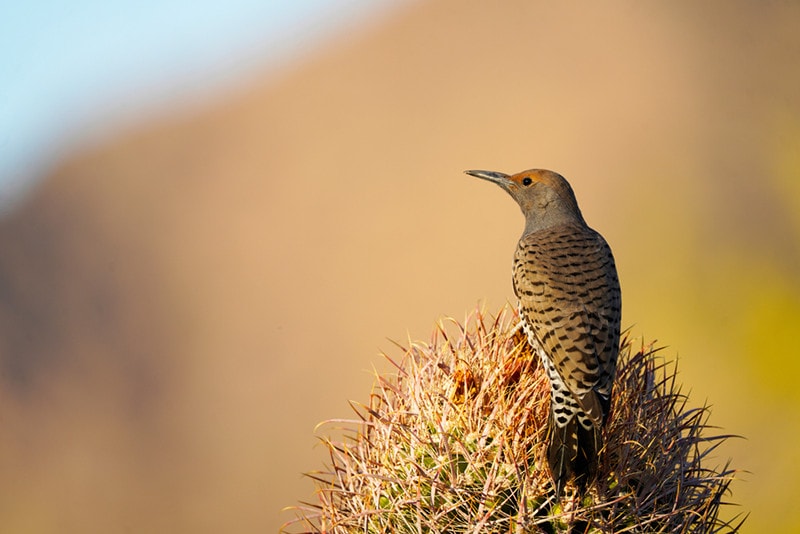Gilded Flicker: Field Guide, Pictures, Habitat, & Info
Last Updated on

If you venture far out into the Sonoran Desert in Arizona, you might catch a glimpse of what looks like a smaller version of the Northern Flicker. This lesser-known bird is called the Gilded Flicker. It likes to reside quietly deep in the desert and isn’t likely to be found in urban areas. In fact, spotting them is a fairly rare occurrence in general since they only live in California, Arizona, and Mexico. Here’s how to identify this closely resembling cousin next time you’re in the area.

All About the Gilded Flicker

| Common Name: | Gilded Flicker |
| Scientific Name: | Colaptes chrysoides |
| Wingspan: | 7”-20.5” |
| Length: | 11” |
| Diet: | Insects |
| Lifespan: | 6 years |
A type of woodpecker, the Gilded Flicker actually rarely nests in trees, although they’ve been known to make a home out of cottonwood cavities. Usually, you’ll find them perched atop giant cacti. During the wintertime when the insect population becomes scarce, these same cacti will double as food and lodging because Gilded Flickers love to eat their seeds. Even so, Gilded Flickers are considered carnivorous and will mostly eat ants they’ve plucked out of the ground with their long, thick bills.
A Gilded Flicker is an average sized bird with an anything but average appearance. They have brown and white stripes on their back, and a creamy, beige chest with black spots outlined in white. Males have a black triangle on their chest and a bright red mark just under their cheeks that look like a child applied rouge. Females look similar to males. They are even the same size, but their feathers are more muted, and they don’t have the bright red facial marking. Both males and females have an apricot crown that covers the top half of their face, and the bottom half of their face and neck are gray.
Even though this bird stays away from busy human dwellings, don’t let their meek appearance fool you. This bird knows how to successfully defend itself from aggressive species such as the Starling that frequently take over other bird nests.

Where to Spot the Gilded Flicker
You might spot the Gilded Flicker gliding across the sky in the Sonoran Desert, its primary home. Although Northern Flickers may live almost anywhere in the U.S., the Gilded Flicker doesn’t venture east or North of Arizona.
Unfortunately, this desert-dwelling bird’s population is dwindling as humans further develop the Sonoran Desert. The Gilded Flicker is included in the Yellow Watch List of birds that are in danger of further population decline in years to come. Given the current trajectory, its population will be reduced by half in the next thirty years if proactive steps aren’t taken to preserve its home.
The oldest known Gilded Flicker was 6 years, 4 months old at the time it was re-released in Arizona.

Summing Up
If you visit the Sonoran Desert, you might have the chance to see the rare Gilded Flicker. They look very similar to the Northern Flicker, which can be found nearly anywhere in America, but this bird’s geographic range is severely limited to the Southwestern United States and Mexico. Their population has suffered in recent years as even the small area they inhabit is taken away from them. Its beloved desert is transitioning into a more urban environment, robbing them of the cacti they call home. The Gilded Flicker is currently on the Yellow Watch List and will need our cooperation to survive the next century of human development.
See also:
- Northern Flicker Male vs. Female: How Are They Different?
- Red-Shafted Northern Flicker: Field Guide, Pictures, Habitat & Info
About the Author Brooke Bundy
Brooke Bundy is a freelance writer who lives with three cats and a dog. She attended the University of North Georgia where she acquired a B.S. in Media Studies. Booke loves storytelling and spending time with her pets at their house in New Orleans, Louisiana. In her free time, she enjoys gardening, cooking, and brewing coffee.
Related Articles:
10 Types of Hummingbirds in Arkansas (With Pictures)
8 Types of Hummingbirds in Nebraska (With Pictures)
5 Types of Hummingbirds in Idaho (With Pictures)
3 Types of Hummingbirds in Mississippi (With Pictures)
8 Types of Hummingbirds in Kansas (With Pictures)
5 Types of Hummingbirds in West Virginia (With Pictures)
5 Types of Hummingbirds in Ohio (With Pictures)
Where Do Nuthatches Nest? Nuthatch Nesting Habits Explained
